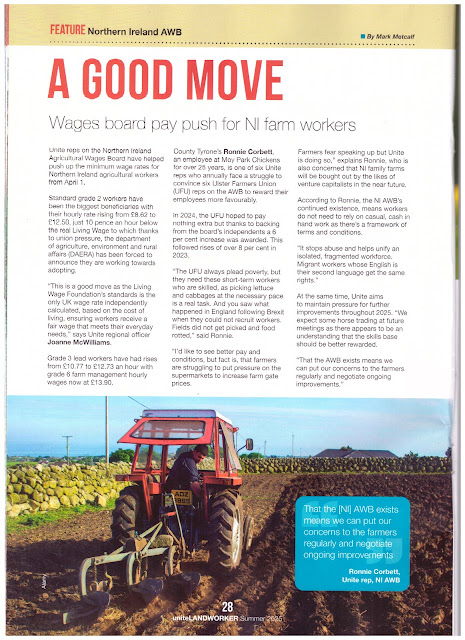Taken from IMAGES OF THE PAST – THE MINERS’ STRIKE BY MARTIN
JENKINSON, MARK HARVEY & MARK METCALF – published in 2014 and republished
in 2024
“IF YOU BUY ONE BOOK ON THE MINERS’ STRIKE BUY THIS ONE” –
DAILY MIRROR
It was in October 1984 that the real possibility of an NUM
victory arose when MacGregor’s arrogance resulted in a dispute with the pit
deputies’ union, NACODS. Early in the strike it had been agreed that NACODS
members would not cross picket lines at strike-bound collieries. When the NCB
chairman ordered them to do so a ballot to strike won an 83% vote for action.
Strike action was planned to start on 25 October 1984.
If it went ahead working pits would be closed down as by law work could only be
carried out at a colliery in the presence of a pit deputy.
Stopping production would have created a major problem for
the CEGB and the government, who must have been terrified at the fear that the
miners’ might deal a third blow – in 12 years – to a Tory administration.
Another defeat may well have caused the British ruling class to question
whether their support for a party used to power was worth continuing in the
future. It would certainly have led to deep recriminations within the Tory
Party, an organisation well used to quickly getting rid of its leaders. Thatcher,
herself, was to find this out in November 1990.
Speaking in 1993 Thatcher was candid when she said: “We were
in danger of losing everything because of a silly mistake. We had to make it
quite clear that if that was not cured immediately, then the actual management of the Coal Board could indeed have
brought down the government. The future of the government at that moment was in
their hands and they had to remedy their terrible mistake.”
With Whitehall’s top officials having outlined to her how
British industry could be forced on a three-day week, an anxious Thatcher
ordered a chastened MacGregor to be “as conciliatory as possible on the points
of substance,” (Downing Street Years) including the withdrawal of his
circular regards crossing picket lines at strike-bound collieries.
After extensive discussions NACODS was persuaded to abandon
their fight to “achieve some form of arbitration in cases of disagreement over
closures” (Downing Street Years) and accepted a mildly souped up pit
closure review procedure just 24 hours before strike action was due to start.
According to Scargill: “the fact that NACODS leaders ignored
pleas from the NUM and TUC not to call off their strike … poses the question –
whose hand did the moving, and why? Over the years, I have repeatedly said that
we didn’t “come close” to total victory in October 1984 – we had it, and at the
very point of victory we were betrayed. Only the NACODS leaders know why.”
In the decade that followed, the new agreement failed to
save a single mine and thousands of NACODS members lost their jobs as a result
of failing to fight pit closures. Following the agreement, Jack Taylor had
warned them that would be the case when he said: “Nothing has changed as far as
the board’s pit closure programme is concerned … only a victory by the miners
will halt that closure programme, save Cortonwood, Bulcliffe Wood and the three
other named pits and stop further closures on economic grounds.”
NACODS example shows that the adoption of more moderate
tactics by the NUM would not have saved the Tories from butchering the mining
industry. Steelworkers adoption of similar tactics in the early 80s had failed
to prevent the decimation of their industry. After the miners’ strike ended
areas that tried to work closely with the Coal Board suffered, like others, a
series of rapid closures.
The Miners’ Strike
In addition to being the most bitter industrial dispute the
miners’ strike of 1984/5 was the longest national strike in British history.
For almost a year over 100,000 members of the National Union
of Mineworkers, their families and supporters, in hundreds of communities,
battled to prevent the decimation of the coal industry on which their
livelihoods and communities depended.
Margaret Thatcher’s government aimed to smash the most
militant section of the British working class. She wanted to usher in a new era
of greater management control at work and pave the way for a radical
refashioning of society in favour of neo-liberal objectives that three decades
on have crippled the world economy.
Victory for her government meant draconian restrictions on
picketing and the development of a militarised national police force which made
widespread arrests as part of its criminalisation policy. The attack on the
miners also involved the use of the courts and anti-trade union laws,
restrictions on welfare benefits, the secret financing by right-wing
industrialists of working miners and the involvement of the security services.
This attack was supported by a compliant mass media but
resisted by the collective courage of miners and mining communities in which
the role of Women against Pit Closures in combating the ensuing poverty and
starvation was heroic. Inspired by the struggle for jobs and communities,
support groups across Britain and the world helped create a situation where the
miners came close to winning their historic struggle.
At the heart of the conflict was the Yorkshire region, where
even at the end in March 1985, 83 per cent of 56,000 miners were still out on
strike. The official Yorkshire National Union of Mineworkers (NUM) area
photographer in 1984-85 was the late Martin Jenkinson and this book of his
photographs – some never previously seen – serves as a unique social commentary
on the dispute that changed the face of Britain.






.jpg)




















